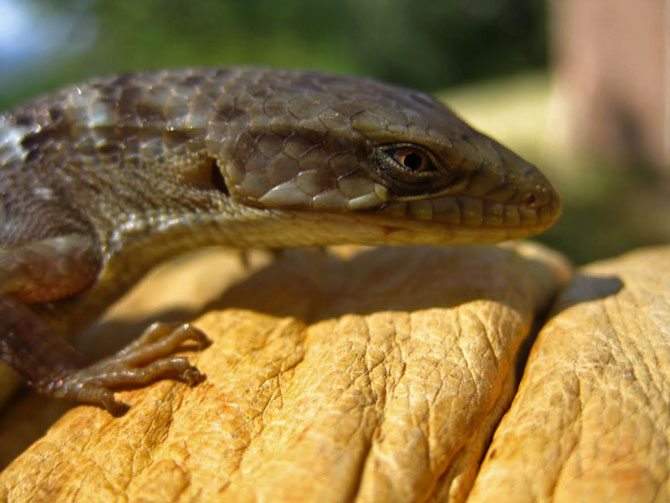It was another beautiful Yosemite morning. I walked out the door onto my sandy lawn to get things started. I grabbed my bike to head over to the office and that’s when I saw… the body. Smooshed on the shoulder of the road was a snake-like yet flattened form. Closer inspection revealed little legs sticking out the side. I assumed it used to have a tail, though the animal must have lost it in some other battle. What was this creature? Being from Wisconsin originally, I’m not exactly from lizard country, so I’ve always been fascinated by them and this was a different specimen than anything I’d ever seen. After a few moments, I was back on my bike and headed for my usual daily adventures. Going about my day, I couldn’t stop thinking about it. What was that? Maybe it was an escaped pet of sorts? Ranger naturalists are naturally curious people, and I decided to do a little bit more investigating.
Before you criticize, understand that I am a naturalist. As a naturalist, I find myself to be more curious than morbid, though sometimes these boundaries get tangled. Being a naturalist in Yosemite doesn’t always mean studying bears and sequoias, those large and charismatic beings that people tend to gravitate to. Sometimes it means looking at the smaller pieces of the puzzle to learn more, and sometimes those pieces don’t look (or smell) so pretty. I had a feeling that there was something more to this little lizard. Tours done for the day, I was back at the crime scene with my deceased reptile and armed with the right kind of tools for this sort of investigation: a stick and a sandwich bag. Securing my specimen as delicately as possible, I hauled it back to the office to meet with a colleague. Guidebooks out, we were ready to tackle this business. Luckily it didn’t take long to nail down our lizard friend (the baggie was not functioning to keep the smell from bothering our slightly less inquisitive colleagues). What we had was an alligator lizard.
Alligator lizard? Is that even a real thing? All I could think of was the song “Ventura Highway” by the band America, made popular back in 1972: “Cause the free wind is blowin' through your hair, and the days surround your daylight there, seasons crying no despair, alligator lizards in the air, in the air!” A very ‘70s song, to be sure (apparently written about sitting on the side of the road as a kid, watching shapes in the clouds as his dad changed his bike tire). It had never occurred to me, in all of the times I had heard that song, that alligator lizards were even a real thing. As a naturalist in a relatively new ecosystem, I was delighted to find out how wrong I was.
So why do we care about alligator lizards? These little lizards are certainly deserving of a song. Aside from eating the spiders that may lurk creepily in the corners of your kitchen (admittedly, another less charismatic piece of the puzzle), they have the ability to directly improve the quality of human life through the prevention of disease. Though we have ticks in the Sierra Nevada, we don’t have as many problems with Lyme disease as other states. Thank your local lizards for this (in part). Alligator lizards (as well as common fencepost lizards) get ticks, too. The specimen found in my yard had a few of his/her own under closer inspection. These lizards have an enzyme in their blood that appears to cure Lyme disease in the ticks that bite them! This is something that scientists are researching to see if they can find a cure for Lyme disease in people, which may someday help many who are suffering from this disease. Alligator lizards are inadvertently protecting our quality of life by slithering about, collecting and curing ticks for us.
One of the greatest naturalists of all time, John Muir, once said "When we try to pick out anything by itself, we find it hitched to everything else in the Universe." These lizards are a piece of the great puzzle that makes our ecosystem here in Yosemite. They may be a piece that when pulled out alone, seems inconsequential. To some, it may even seem ugly. Nonetheless, they are part of a greater picture, and you know how beautiful that greater picture can be in the Sierra Nevada. Even if you do not adore the creature when considered alone, appreciate its potential. Take time to get to know those smaller pieces of the puzzle when you’re here in Yosemite. This doesn’t mean examining roadkill necessarily, but perhaps contemplating smaller facets of this place—plants and animals that may seem inconsequential—or even ugly to you. The more pieces to the puzzle you can collect and understand, the more beautiful and complete the greater picture will be.

